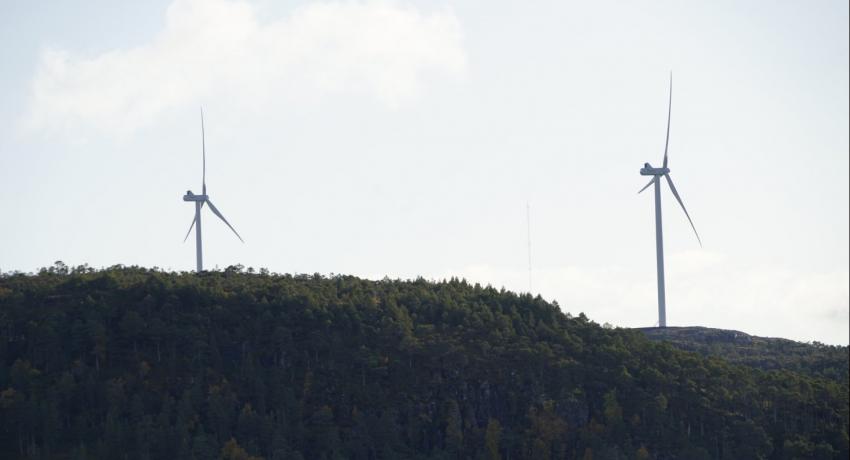The transition to renewable energy makes it more important for power producers to get accurate information about the weather that is to come. Climate scientists are currently investing considerable effort and resources to help them get better long-term forecasts.
“Sub-seasonal and seasonal forecasting – meaning forecasts for the next few weeks and months – is still at an early stage, and it is very challenging to provide accurate predictions,” says Jana Sillmann, research director at CICERO Center for International Climate Research.
“Nonetheless, substantial progress has been made in the last decade, and these forecasts are now able to predict the evolution of some large-scale extreme weather events several weeks in advance,” Sillmann says.
In a comment published on 17 February in the scientific journal Nature Energy, Sillmann and her colleague Anton Orlov, senior researcher at CICERO, and Ilaria Vigo, environmental economist at Barcelona Supercomputing Center, explain how the energy industry can benefit from better and more reliable seasonal forecasts.
Sub-seasonal and seasonal forecasts are now able to predict the evolution of some large-scale extreme weather events several weeks in advance.
JANA SILLMANN, RESEARCH DIRECTOR AT CICERO CENTER FOR INTERNATIONAL CLIMATE RESEARCH
More weather-dependent power production
More renewable energy is highly needed if the world is to manage to cut carbon emissions enough to limit global warming to maximum 1.5°C. However, because the production of clean energy is highly weather-dependent, the expansion of renewables makes the power supply more vulnerable to changing weather conditions.
Very little wind power is produced when the wind does not blow, and no solar power is generated when there is no sun. Meanwhile, hydropower production is dependent on precipitation leading to water in rivers and in hydropower reservoirs and can thus be markedly affected by climate extremes such as droughts and floods.
How much clean power is produced has a huge impact on power prices, and because the fuel needed for renewable power generation – wind, sun and water – is available free of charge, the marginal costs of renewable power production are close to zero.
The more power is generated by wind, solar and hydropower plants, the lower are wholesale electricity prices, and when renewables production is low, power prices tend to increase.
Power demand is also weather-dependent
Power demand is also highly dependent on the weather and tends to increase when the weather is cold, and people turn on their electric heaters. But the demand for electricity also raises when it gets so hot that air conditioning is needed for cooling down.
Weather conditions that are not in line with the seasonal norm – such as extremely cold winters or unusually hot summers – can result in unseasonably high or low electricity demand, and to higher or lower renewable power generation than normal.
The weather is therefore an important determinant of wholesale electricity prices. However, energy companies often sell their electricity output in the forward market well in advance, and prices on power contracts for the weeks and months ahead are to a large degree dependent on the expected power demand and supply of clean energy.
Can lead to more successful energy trading
Whether or not energy market participants have made a good deal becomes clear when the delivery day comes: if the settlement price on the energy exchange – the so-called electricity spot price – out-turns lower than the price for delivery the same day in the forward market, then the forward contract was overvalued. And vice versa: if the forward price is lower than the spot out-turn, the forward contract was undervalued.
Predicting the weather plays a crucial role in electricity price forecasting and seasonal forecasts can thus help energy companies improve their hedging strategy, explains Orlov.
“Having information about how hot, cold, humid, dry or windy the upcoming season will be can be critical for estimating how high or low both power demand and renewable power production will be that season,” Orlov says.
Helps improve decision-making and planning
“Sub-seasonal and seasonal forecasts can also help renewable energy companies and grid operators improve risk management practices, accounting for climate variability,” says Vigo.
Seasonal forecasts can help renewable energy producers plan their production with greater accuracy and over longer timeframes, leading to improved performance of renewable energy businesses, she explains.
Sub-seasonal and seasonal forecasts can also help renewable energy companies and grid operators improve risk management practices, accounting for climate variability.
ILARIA VIGO, ENVIRONMENTAL ECONOMIST AT BARCELONA SUPERCOMPUTING CENTER.
“Forecasts for the weeks and months ahead can also make power producers become aware of the risk of disruption and damage from storms and flooding at an earlier stage, enabling them to better prepare for such events,” Vigo adds.
Climate change makes seasonal forecasts more important
“The challenges posed to energy companies by changing weather will be further exacerbated by climate change because it will lead to more extreme weather, and this makes it even more important to continue to improve sub-seasonal and seasonal forecasts to make them more reliable,” says Sillmann.
Unlike normal weather forecasts, seasonal forecasts take the future climate into account by giving skill scores that measure the accuracy of the forecasts. If the skill score is positive, this means that the forecast is more accurate than climatology – which relies on past observations and is usually the basis for decision-making in the renewable energy industry, she explains.
“Although usually too coarse and not meant to simulate specific weather events, climate models can thus inform us about the increased chances of more extreme seasons at the regional level,” Sillmann adds.
Climate change has the potential to bring extreme variability to both the demand for and the supply of electricity, and such variability can result in adverse economic implications for renewable power producers, especially if they are unforeseen.
ANTON ORLOV, SENIOR RESEARCHER AT CICERO CENTER FOR INTERNATIONAL CLIMATE RESEARCH
More extreme weather ahead
Before the end of this century, climate change is expected to lead to a shift in extreme precipitation in many regions – particularly in Northern Europe and North-Eastern America – from summer and early autumn towards late autumn and winter, explains Sillmann.
Heatwaves are expected to become more intense, more frequent and longer lasting in Europe and North America, and the duration of cold spells is anticipated to decline.
Moreover, in the Mediterranean region, droughts are expected to start earlier and last longer, and in North Sea coastal regions, reductions in the mean sea-level pressure level will lead to more storms.
“Climate change has the potential to bring extreme variability to both the demand for and the supply of electricity, and such variability can result in adverse economic implications for renewable power producers, especially if they are unforeseen,” says Orlov.
The S2S4E project
Sillmann, Orlov and Vigo are all involved in the research project S2S4E (Sub-Seasonal to Seasonal Climate Forecasting for Energy), which is funded by the EU's research and innovation programme Horizon 2020.
S2S4E is working to make long-term forecasts more reliable and useful, and to achieve this goal, the project has developed a new forecasting tool – the S2S4E Decision Support Tool – which will remain free to use until the end of November.
The S2S4E Decision Support Tool has been specifically developed for the energy sector, and it shows the global climate outlook, with prognosis for precipitation, solar radiation, temperature, wind speed and power demand ranging from one week to three months ahead.
The S2S4E project is coordinated by Barcelona Supercomputing Center and the 12 partners in the project come from seven different countries in Europe (Spain, France, Norway, Germany, Italy, United Kingdom and Sweden).
For specific information about the S2S4E project, please contact us
Written by Iselin Rønningsbakk / CICERO Center for International Climate Research.
References
- Orlov, A., Sillmann, J. & Vigo, I. Better seasonal forecasts for the renewable energy industry. Nat Energy (2020). https://doi.org/10.1038/s41560-020-0561-5.


